
Bulletin 3431
Bulletin E-3431 How to Read a Seed Guide (Soybean Edition)
DOWNLOAD
January 16, 2025 - Jonathan LaPorte and Jenna Falor, Michigan State University Extension
Raising a profitable crop begins with selecting the right seed product to plant on your farm. Seed product options are found in seed guides, available from seed companies or related seed dealers. Seed guides can be a little tricky to understand if you don’t have experience reading them or if switching between companies. The trickiness exists because every company sets up their guides slightly differently. For example, when reading seed guides you will notice that not all seed companies will follow the same seed numbering conventions. They may not even use the same rating scale for plant characteristics.
While there are differences between how companies set up their seed guides, there are also a lot of common types of information. Discussed in this document are definitions and explanations of the types of information you will likely find mentioned across most soybean seed guides. Each section will also highlight why it is important to make sure you understand seed guide information versus making assumptions. We’ll also review how costs and harvest factors are important considerations in selecting seed options for your farm.
Let’s Start With the Numbers
Variety numbering systems are the conventions by which companies name their different soybean varieties. These conventions may use a combination of abbreviations for their company name, relative maturity (RM) numbers, and possibly trait information to identify varieties.
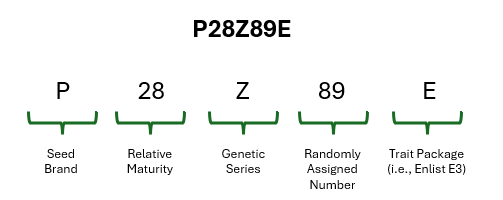
Figure 1. Explanation of soybean variety numbering from Pioneer Hi-Bred brand seed. Photo by Jon LaPorte, MSU Extension.
Example 1. Pioneer will always start with a P for Pioneer, followed by two numbers for the comparative relative maturity which will be further explained in the next section. The relative maturity is followed by a letter representing the genetic series the variety belongs to and two random numbers. Finally, there may be letters at the end for particular traits. An example would be P28Z89E, which has a relative maturity of 2.8 and is part of the Z series of soybeans with the Enlist E3 trait package (Figure 1).
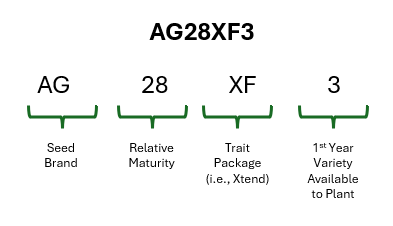
Figure 2. Explanation of soybean variety numbering from Asgrow brand seeds. Photo by Jon LaPorte, MSU Extension.
Example 2. Asgrow will always start with AG followed by the next two numbers also representing relative maturity. There may also be letters for particular traits, which will be further explained in the next section. Lastly, a number at the end indicates the year a variety was first available to plant. An example would be AG28XF3 which has a relative maturity of 2.8 (Figure 2). It was first available to plant in 2023, so the final number of “3” is used in the name.
The point of these examples is to show that you can’t assume all seed companies have the same numbering systems. If you are looking at different seed brands, make sure to look at the information provided and understand the numbering system that the company uses.
An additional characteristic of a numbering system may be how trait packages are listed. In Figure 1, the variety number includes the letter E, which stands for Enlist E3. In Figure 2, the variety number includes the letters XF which stands for XtendFlex. Enlist E3 and Xtend refer to trademark names of traits within the plant. Both traits in the examples are for herbicide tolerances that the specific varieties possess. Not all soybeans have the same traits. Seed companies also offer non GMO varieties which have no resistance to herbicides. Non GMO varieties rely on the grower to use conventional herbicides. More information on traits will be provided in the “Identify Desired Characteristics” section of this publication.
Another thing that will vary by company within seed guides is their rating system. The company research agronomists determine these rating systems. In one case it may be a 1-9 rating system with 1 being the best rating for one company and 9 being the best rating for another company. Other companies will use more descriptive terms such as poor, good, very good, and excellent. Again, it is important to understand which rating scale the company is using to ensure you are buying what you need. A helpful tip when reviewing a scale is to identify if any variety ranks are listed with a lower number. You won’t often see many products that rank at the lowest number on the scale being used. Those variety options are usually weeded out during the development phase and never make it to a commercial release. If you see a variety with a lower number ranking, it is likely an indicator of the scale being used but you should confirm this within the guide.
Soybeans 101
Soybean seed for commercial planting are developed through selective breeding and may also involve genetic modifications. The goal is that a variety will possess the best attributes and perform in a consistent manner. However, sometimes less desirable attributes may still be present, especially if a variety scores among the best for a particular challenge growers are facing. These mixtures of different characteristics are what make seed selection both important and challenging.
You’ll need to identify characteristics important for a successful soybean crop on your farm. Just as no two farms are exactly alike, neither are the fields where you’ll be planting. You need to understand the field conditions and potential environment where you expect a soybean plant to grow, then select varieties for those conditions.
A common starting point is to identify what maturity of soybean you need for your growing region and your estimated planting date. However, before opening a seed guide, you need to think about how you define when soybeans have reached maturity. Many seed guides will list maturity by two terms: relative maturity (RM) and growing degree days (GDDs). Relative maturity focuses on harvest maturity, while GDDs focus on physiological maturity. Let’s explore the differences.
Relative Maturity (RM)
Relative maturity is known as the days needed to reach harvest maturity. Harvest maturity is when grain can be harvested with minimal loss or seed damage. Under ideal field conditions, harvest occurs when soybeans have naturally dried to a grain moisture content of 13%. However, weather can impact how long it takes to reach ideal moisture levels. Temperature, humidity and water availability can delay or speed up the drying process. Temperature also affects the number of days required for a plant to begin flowering. Warmer temperatures can speed up flower development while cooler temperatures can delay flowering. With weather as an important factor, RM days should not be considered the same as calendar days from planting.
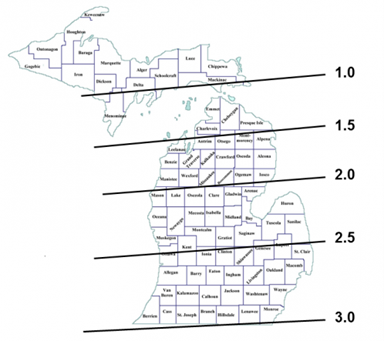
|
Figure 3. Soybean maturity zones in Michigan. Adapted from Zhang, L.X, Kyei-Boahen, S, Zhang, J., Zhang, M.H., Freeland, T.B., Watson, C. E., Jr., and Liu, X.M. 2007. Modifications of optimum adaption zones for soybean maturity groups in the USA. Crop Management. |
Soybean varieties are classified based on their morphological growth habit and daylength and temperature requirements to initiate floral or reproductive development (Pedersen, 2024). The importance of daylength relates to soybeans being sensitive to photoperiods, or the exposure to light in a 24-hour period. As days get shorter in late summer, soybean plants will be exposed to less sunlight and begin to mature more rapidly. Soybeans are sometimes referred to as being “night-length” sensitive because of their response to decreases in sunlight.
Due to soybeans being responsive to so many environmental factors, RM is grouped into maturity zones. Maturity zones follow narrow ranges of latitude where environmental conditions are relatively the same. In Michigan, the primary maturity zones are 0-3, depending on your location (Figure 3).
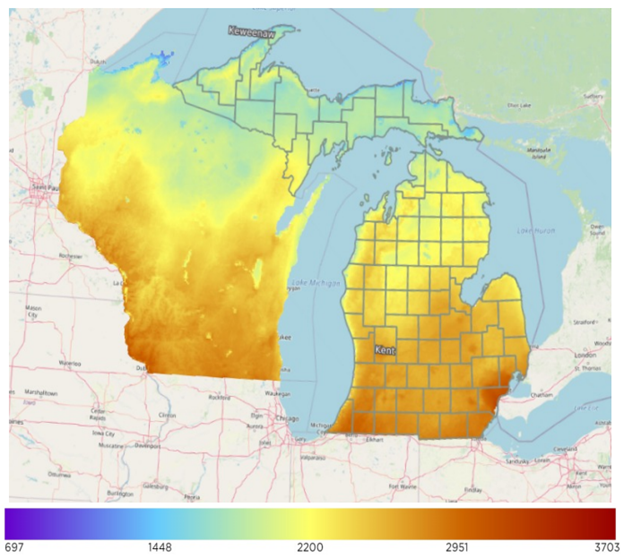
|
Figure 4. Average cumulative Growing Degree Days (50F) from 1991-2020 from MSU Enviroweather. Photo created by Jon LaPorte, MSU Extension per data map creator at MSU Enviroweather. |
Each seed company may have additional factors that are used to determine relative maturity. It is not surprising to find two different seed companies have varieties with identical RMs that reach maturity a few days apart.
Today, each company establishes RM based on how many days before harvest a variety needs to reach maturity. The numbers of days needed are then compared to an established “standard” variety. For example, a soybean with a RM of 2.4 is suited for maturity zone two and matures two days later than a soybean with a RM of 2.2.
Seed selection based solely on RM should include reviewing harvest conditions, access to equipment and drying capabilities—especially in situations where you custom hire your harvesting or have limited drying capacity on-farm. Added costs and delays during adverse harvest conditions can reduce potential benefits of some variety options. An effective strategy to reduce potential risks from adverse harvest conditions is to select multiple varieties within your maturity zone.
Growing Degree Days (GDDs)
Heat can strongly influence how fast or slowly soybeans develop and reach physiological maturity. Growing degree days, or heat units, are the accumulation of heat given a set temperature range. GDDs are researched and used to estimate the amount required to reach each crop growth stage (Figure 4).
Physiological maturity is when the plant has reached the 7th reproductive stage (R7) where one pod has attained its mature color. The R7 growth stage signals that a soybean plant’s development has stopped and is no longer taking in water or distributing plant sugars in the seeds.
Most companies use RM rather than list GDDs in their seed guides. If companies do list GDDs, they may be an actual number or grouped together in categories. For example, early maturity varieties may list 2,300 GDDs, while late season maturity may list 2,800 GDDs.
If your seed company lists GDDs to help with seed selection, it is important to understand the typical range of days in your area. The goal should be to select varieties that will reach physiological maturity prior to a severe or “killing” frost or to allow the timely planting of winter wheat or cover crops. Choosing a variety with GDDs within your region’s normal range minimizes potential harvest loss. To review GDDs in your area, visit MSU’s Enviroweather website (https://enviroweather.msu.edu/weathermodels/growingdegreedays).
Identify Desired Characteristics
Seed guides offer information on a number of different plant attributes. Attributes include growth factors that focus on plant health and survivability, harvest condition and quality of grain, tolerance or safety concerns when using herbicides, and even disease resistance or susceptibility. All of these are important when considering the field conditions on your farm.
Growth Factors
Plant health is a key consideration when selecting a soybean variety for your farm. From planting to harvest, growth expectations will largely determine if a soybean plant can produce quality, harvestable seed for sale.
|
Figure 5. Medium bush soybean variety planted in narrow row width of 15 inches. Photo by Jon LaPorte, MSU Extension |
Emergence is how quickly and uniformly a plant emerges from the soil. Ideally, all planted seeds will sprout and emerge together. Uniformity keeps growth stages roughly equal across a field and impacts nutrient, pesticide, and even water applications. Uneven emergence means delayed plants may not fully mature by harvest time. Emergence can also be a factor in planting date decisions. Varieties with poor emergence need consistent temperatures above 50oF and sufficient moisture to achieve uniformity.
Canopy/plant type refers to the plant shape and ability to cover open row spacing. Row closure can aid in preventing weed growth by limiting their access to sunlight and increasing sunlight capture to maximize yield potential. Thin canopies offer the least amount of row coverage. Medium-Thin, Medium, Medium-Bush, and Bush type canopies offer the most row coverage (Figure 5).
Standability focuses on how strong a plant’s stem is through the season. Sturdy stalks can support soybean pod growth, withstand strong winds from adverse weather, and stand longer in delayed harvest conditions.
Plant height refers to whether a plant is tall, medium, or short. Soybeans are often listed as medium short (MS), medium (M), medium tall (MT) or tall (T). A common misconception is that plant height influences the length and number of nodes (where pods form). Shorter plants, especially when planted later in the season, tend to set pods closer to the ground. Lower seed pods can cause increased harvest losses, especially on uneven ground or in fields with many stones. Temperature and moisture are key factors for node formation. Taller plants are ideal for situations that require more leaf area for canopy while plants of medium height are ideal for most planting situations, as long as sufficient nodes exist for pod formation. Plant height should be compared to planned row widths, growing conditions, and standability ratings.
Chloride Sensitivity refers to whether the plant prevents translocation of salt or chloride to its growing point. A seed guide will sometimes list the variety as an includer or excluder. Includer soybeans translocate salt or chloride to the growing point, leading to chlorosis (yellowing), stunting, and yield loss. Avoid planting these varieties in soils that are sodic (high sodium levels) or saline (high salt levels). Excluder soybeans separate and discharge chloride from the plant to prevent stunting and yield loss. Varieties that are excluders are ideal for sodic soils. Note: Sodic or saline soils are uncommon in Michigan but may be present in soils that have water or root penetration concerns. Conditions may also be present where irrigation water has been infiltrated with saline water.
Other Characteristics
Not all growth characteristics listed in a seed guide have an agronomic impact on yield potential. However, their appearance can be more or less desirable based on personal preference. The following growth characteristics are often found in seed guides:
Average Seed Size can vary from small to large among varieties. Although there is no agronomic difference between seed sizes, adjustments to planting equipment may be needed to maintain seeding accuracy. Planting depth, soil moisture, and texture are important considerations with regard to seed size. For more information review the MSU Extension article: Soybean planting depth matters (www.canr.msu.edu/news/soybean_planting_depth_matters).
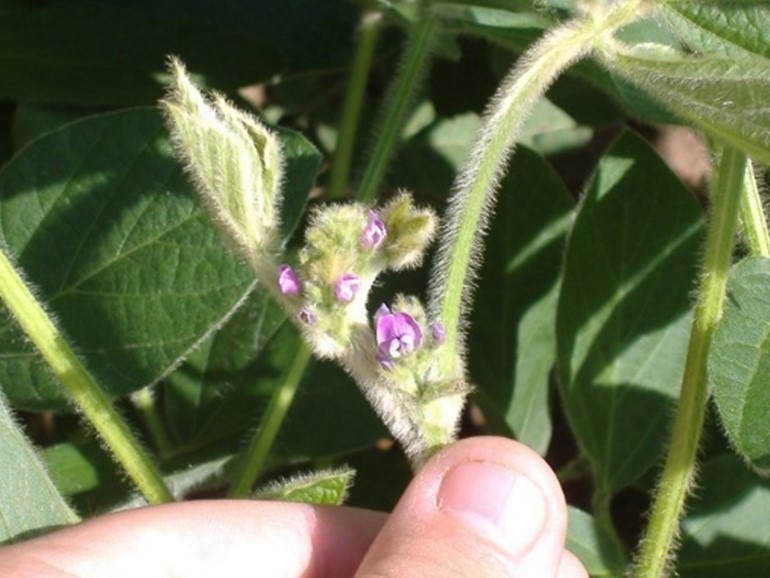
|
Figure 6. Example of a purple flower and grey pubescence on a soybean plant. Photo by Jon LaPorte, MSU Extension. |
Flower Color on soybeans are often purple or white (Figure 6).
Hilum Color, or the “eye” of a soybean seed, can be black, brown, buff (light brown), or some variation of these colors.
Pubescence Color on stems or pods can be brown (tawny) or grey (Figure 6). A common misconception about grey pubescence is that the soybean plant is not as healthy and is more susceptible to diseases.
Pod Color at physiological maturity can be tan, brown or black. A common misconception about brown or black pods is that they indicate disease injury, despite no evidence of disease presence and a healthy plant appearance.
Pesticide Use and Disease Ratings
Each seed guide lists several diseases and a plant’s susceptibility toward them. A better rating indicates the plant is less susceptible to disease development and injury while a lower rating indicates higher susceptibility and the greater potential for yield loss. A lower disease resistance may also require additional pesticide use in the form of fungicides for fungal diseases.
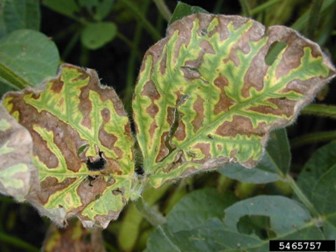
|
Figure 7. Leaf symptom of Sudden Death Syndrome in soybeans. Photo credit by Daren Mueller, Iowa State University, Bugwood.org www.ipmimages.org/browse/detail.cfm?imgnum=5465757 |
Diseases listed in a seed guide may cause root rot, leaf (foliar) or pod damage and will vary across companies and regions. Some of the more common diseases in Michigan are Phytophthora root rot, sudden death syndrome (SDS, Figure 7) and white mold. If disease is present, yields can be reduced as seed quality is reduced (directly or indirectly). Diseases impacting root and leaf growth will also impact water or nutrient uptake and photosynthate production, which impacts yield but may not affect seed quality.
While a higher disease resistance rating can limit impacts to plant health and yield, fungicides may still be needed if environmental conditions favor disease presence or injury. A general rule of thumb is that there is a higher chance of return on investment (ROI) for fungicides as a preventive measure when conditions are favorable for disease development. To learn more about soybean diseases and management tips, visit the Crop Protection Network (https://cropprotectionnetwork.org/).
Pest information can also be listed in a seed guide. For Michigan, susceptibility to soybean cyst nematodes (SCN) is a significant concern. Some varieties offer better protection against nematodes based on the source of resistance they contain. Seed guides may list the resistant traits (Peking, PI 88788, etc.) or list a resistance rating. For more information visit MSU’s Soybean Cyst Nematode website: www.canr.msu.edu/tag/soybean-cyst-nematode.
Plant safety and tolerance to pesticide application can also be listed in a seed guide. Pesticides are used not only for diseases but also for weed and insect suppression or prevention as well. Herbicides in particular may cause plant damage even at labeled use rates. Tolerance is usually listed as acceptable, caution or warning. Acceptable ratings indicate crop injury is unlikely. Caution indicates crop injury is possible if adverse environmental conditions are present. Warning indicates crop injury will occur even with good environmental conditions.
Disease comments in this section provided by Martin Chilvers, Michigan State University.
Genetic Traits
In addition to pesticide use and disease ratings, soybean varieties may be genetically modified with additional management attributes. When a plant is modified, and its resistance is not naturally occurring, this is referred to as genetically modified organisms (GMOs) or simply “traits.” Some GMO plants can affect the quality or characteristics of plants. Plenish soybeans for example are high in oleic acid and low in linoleic acid, which may be desirable for human or animal consumption. Other GMO plants have traits that focus on management attributes, such as providing their own protection against pests, injury from pesticides, or environmental stress conditions. A common example seen for soybean seed selection are herbicide traits.
Herbicide Traits refer to genetic attributes that allow a plant to detoxify herbicide active ingredients. Once detoxified, herbicides are considered inert within a plant’s metabolism and will not harm plant tissue. Weeds that do not have the same ability to detoxify active ingredients will be susceptible to injury. Examples of herbicide traits include Roundup Ready, Enlist and Liberty Link. Non GMO varieties will not include one of the above traits and will require the careful selection of conventional herbicides.
Production Practice Ratings
Seed guides often focus on specific growth characteristics of soybean plants. However, seed companies recognize that how soybeans are planted can be a determining factor in yield performance. Some seed companies provide basic information on production practices for which a variety may be best suited. Examples may include:
No-Till Adaptability is when a variety is considered ideal for no-till planting systems.
Narrow vs. Wide Row ratings indicate whether a variety is ideal for planting in narrow or wide row spacing.
Additional production practice ratings may be included in seed guides. Be sure to compare production practice ratings against growth characteristics to determine whether a potential seed variety is an ideal fit for your farm.
Reading the Guide and Selecting Some Options
Identifying local conditions and what you need from a soybean variety is key to successful seed selection. Understand the differences in regional climate, field conditions, intended uses, and potential pest or environmental concerns. Outline the criteria you need soybean varieties to meet before opening a seed guide. Knowing your criteria helps you select potential options that meet your needs.
Once you’ve selected some options, review soybean variety trial information across multiple locations. Variety trials are a great source of information when comparing variety seed options. Listed by relative maturity, you can identify which soybean varieties are consistent performers. Most importantly, trials can provide an idea of what varieties have or may perform well in your area. Trials are conducted by universities, seed dealers and sometimes even local farms. Contact your local seed dealers for the latest in variety trial information. For more information on MSU’s soybean variety trials, visit: www.canr.msu.edu/varietytrials/soybean/.
Identifying the Cost of Seed Selection
There’s still one more step in the seed selection process. Once you’ve identified the top performers, the final step is to identify the costs of those potential varieties.
Cost Per Bag vs. Cost Per Acre
Identifying seed costs begins with knowing the price of an individual variety. Seed is sold in fairly standardized units regardless of packaging (bag, tote, or box). For soybeans, seed is sold in equivalent per bag units. The standard for most companies is to have 140,000 seeds per bag, although some companies offer fewer seeds per bag (130,000). Seed boxes may also differ with some containing 50 bags per box or only 40 bags depending on the company. Identifying the amount of seeds per bag is your first comparison point between seed options.
Once you know how many seeds are in a bag, price per bag information is your second comparison point. For example, a seed box may contain seven million soybean seeds or 50 bags at 140,000 seeds per bag. If the price per bag of an individual variety is valued at $60, multiply the price per bag by 50 bags to find the cost of the seed box, or $60 x 50 = $3,000. If a second variety is valued at $50 per bag, the cost of a seed box would be $2,500 or $500 less than the first variety.
The third comparison is between the trait packages. Some varieties you’ll consider will have identical traits (multiple herbicide resistances) while others will only offer certain traits (resistance to only one herbicide). Understanding which traits are offered helps to differentiate between varieties and their potential value to your farm.
Table 1. Example comparison of soybean varieties, traits, and prices.
|
Soybean Varieties |
Herbicide Tolerances |
Price Per Bag |
|
Variety 1 |
Glyphosate, Glufosinate, 2,4-D (Enlist E3) |
$60 |
|
Variety 2 |
Glyphosate (Roundup Ready) |
$50 |
As Table 1 outlines, variety 1 offers tolerance to multiple herbicides at a price of $60 per bag. Variety 2 offers tolerance to only glyphosate herbicides at a price of $50 per bag. At a difference of $10, variety 1 may appear to offer more value. However, if you only plan to apply glyphosate herbicides, variety 2 may have better value.
Desired planting population can be just as economically impactful as the price per bag. Planting population can be based on a number of factors, including growth characteristics, soil types, germination ratings, potential for certain diseases, row spacing, planting date and even personal preference. Therefore, planting or seeding rates should be your next comparison point between varieties. Additional information on profitable planting rates can be found through MSU Extension’s on-farm research, highlighted in the article: Thin soybean standards can produce surprisingly high yields (www.canr.msu.edu/news/thin-soybean-stands-can-produce-surprisingly-high-yields).
Continuing with the same two variety examples, let’s consider differences in planting rates.
Table 2. Example comparison of planting rates on soybean variety costs.
|
Soybean Varieties |
Price |
Recommended Planting Rates |
Seeds |
Acres Per Bag |
Cost Per Acre |
|
Variety 1 |
$60 |
140,000 seeds /acre |
140,000 |
(140,000 ÷ 140,000) |
$60 ÷ 1 |
|
Variety 2 |
$50 |
160,000 seeds /acre |
140,000 |
(140,000 ÷ 160,000) |
$50 ÷ 0.88 |
As Table 2 outlines, variety 1 is recommended at a planting rate of 140,000 seeds per acre. Dividing by 140,000 seeds per bag, one bag of variety 1 will plant one acre. At a cost per bag of $60, the cost of planting variety 1 would be $60.00 per acre. In comparison, variety 2 is recommended at a planting rate of 160,000 seeds per acre. The same calculation reveals one bag of variety 2 will plant 0.88 acres. At a cost of $50 per bag, the cost of planting variety 2 would be $57.14 per acre. With the consideration of planting rates, a marginal difference of $2.86 per acre exists between the two varieties.
Which variety should you choose?
The answer lies in reviewing your farm’s criteria for what it needs out of a soybean variety. Growth factors become an important part of the decision once you begin to look at the final cost per acre between varieties. In the above example, it can be assumed that growth factors are similar between the two varieties. If that were not the case, the choice could easily rest on which variety’s attributes best meet your intended use or needs on the farm.
Alternatively, you may have multiple needs on the farm that could be served by both varieties. Perhaps variety 1 is best suited to particular fields where specific weed pressure has been more notable and you need more herbicide option whereas variety 2 may be better suited to fields that meet separate criteria. For example, variety 2 could have a better emergence and seedling vigor rating, making it ideal for earlier planting dates. In many cases, farms will also hedge their investment and look at purchasing multiple options to maximize their potential soybean crop. This is important because a variety that performed well one year may perform poorly the next year because of many different environmental factors.
Harvest Cost Considerations
Harvest time costs can also be helpful when comparing soybean varieties. The condition of the soybean plant and seed at harvest can impact both quality and potential revenues. Commercial grain buyers will grade soybean bushels based on a number of factors including test weight, moisture content, seed damage, heat damage from drying, and even non-grain or foreign material. Grain that is sold without meeting these standards is discounted by fee or reduced bushels. The most common and impactful with regard to seed selection are standard test weight and ideal storage moisture.
Test weight is a measurement of the density of soybean seeds. Denser seeds weigh more and can lead to high yields since fewer seeds are needed to equal a bushel. Ideal storage moisture is when grain moisture content is 13%. If harvest moisture is higher than 13%, drying grain will add time and costs that reduce potential revenues.
Test weight and moisture ratings are not often included in seed guides. To consider test weight and moisture content, be sure to review soybean variety trial information. Trial results will list the test weight and moisture content of each variety. Comparing test weight and moisture levels with potential discounts can give you an indication of harvest time costs. By combining costs with potential revenues, you can then identify varieties that will perform and be profitable for your farm. For more information on soybean moisture and test weight discounts, visit: www.canr.msu.edu/news/understanding_soybean_discount_schedules.
Seed Selection Cost Comparison Decision Tool
The Seed Selection Cost Comparison Decision Tool considers all costs to seed selection and helps to identify which options maximize production and profitability. Tool comparisons provide a ranking for each seed variety based on yield and economic returns. These rankings illustrate top production and profitability options to consider in making seed purchases. To download the Seed Selection Cost Comparison Decision Tool, visit: https://www.canr.msu.edu/resources/seed-selection-cost-comparison-decision-tool
Another resource to pair with the decision tool is the MSU Variety Trials (www.canr.msu.edu/varietytrials/). Trial data include information on test weights, moisture and yields. Variety trial information can be especially helpful when considering specialty soybeans, such as non GMO and high oleic. Premium price opportunities exist for some specialty soybeans which are normally contracted through a soybean processor with variety selection being one factor in the contract. In many cases specialty soybeans are used for food, so extra effort is needed for record keeping, identity preservation and the possibility of needing on-farm storage to allow for delivery at the buyer’s request.
Closing Thoughts
Selecting the right seed for your farm starts and stops with profitability. You want to select varieties that are adaptable and will maximize yields across all acres. Selection starts with identifying local conditions and what you need from a soybean variety. Understand the differences in regional climate, field conditions, intended uses and potential pest or environmental concerns for your farm. Knowing your needs helps you to select potential options.
Often all the information needed to select soybean varieties is in the seed guide if you take time to read it. MSU Extension recommends that if you have questions as you review a seed guide, reach out to the company or your local agronomist. These individuals can best answer questions about a product they sell or work with.
The final key to profitability is to consider more than just yields. The economic returns related to seed and harvest costs are equally important, which include seed purchases, test weight, moisture shrink loss and drying charges.
Reference
Pedersen, P. (2024). PM 1945 Soybean Growth and Development. Iowa State University Extension and Outreach.



 Print
Print Email
Email






